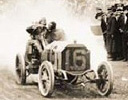Book Review
by Russell Jaslow
The Limit
Life and Death on the 1961 Grand Prix Circuit
by Michael Cannell
Twelve
ISBN: 978-0-446-55472-5. List Price: $25.99.
  Mention the year 1961 to a sports fan, and immediately the famed battle between Mickey Mantle and Roger Maris and their attempt to break Babe Ruth’s single season home run mark will come to mind. Mention the same year to a Formula 1 fan, and the epic battle between Phil Hill and Wolfgang von Trips for the World Driving Championship will come to mind. Mention the year 1961 to a sports fan, and immediately the famed battle between Mickey Mantle and Roger Maris and their attempt to break Babe Ruth’s single season home run mark will come to mind. Mention the same year to a Formula 1 fan, and the epic battle between Phil Hill and Wolfgang von Trips for the World Driving Championship will come to mind.
This is the background to Michael Cannell’s The Limit, which reads like a novel, has the ability to enthrall the aforementioned sports fan who thought of the baseball duel first, and could just as easily be a classic Greek tragedy.
When I first started reading the book, I admit a healthy dose of skepticism. This was due to having recently read a book by another “car ambivalent” New York City writer who knew nothing about auto racing. That book, Blood and Smoke, written by Charles Leerhsen was a colossal failure. I feared the same would be the case with Cannell.
In fact, Cannell admits to the same background in the Acknowledgments section, “I'm an unlikely person to write a book about car racing. Like many New Yorkers, I don't own a car. Nor am I a particularly impassioned driver.” See why I had a healthy dose of skepticism?
Luckily, unlike Leerhsen, Cannell learned to respect the sport, the participants, and even the danger, no matter how ludicrous the risks seemed to be even from those of us who love the sport. There has been some criticism Cannell concentrated too much on the dangers of the sport and over emphasized the graphicness of some of the fatal crashes.
Perhaps for someone coming from the outside, that was inevitable. However, let’s face it, as a friend of mine once said, it is amazing to think the sport ever survived that era with the death toll it had. Sometimes, it takes someone from the outside to remind us of that.
Unlike Leerhsen’s handling of the dangers of racing, Cannell doesn't use it as a means to damn the sport. He uses it as a means to describe the sport, and more importantly, to properly depict the characters and their personalities’ makeup as they are forced to cope with the ever present reality they may not last the year.
This book is ultimately a psychological study of the people involved in racing, especially the two main characters, Hill and von Trips, and the leading supporting role, Enzo Ferrari. Both drivers came from completely different backgrounds, yet with troubled upbringings. Both were unlikely racers, yet rose to the pinnacle of their sport. Both drove with opposite styles, yet excelled at their craft.
It is this character study where the book excels. The author is able to get into the heads of all the participants, providing the reader with an insight rarely experienced in sports books, never mind racing books. Cannell was lucky to have great resources at his disposal. Hill was still alive at the time for in-depth interviews. Von Trips kept an extremely extensive diary throughout his life which was the closest thing to interviewing him in person.
Cannell was able to use these and other resources and interviews to give us a detailed picture of the years and careers of the main characters leading up to the 1961 season. In fact if there is one flaw in the book, he spends too little time on the actual key season, making it almost anticlimactic.
This is an effort of more than just facts and figures, and will appeal to not just the racing fan, not just the sports fan, but anyone who enjoys human drama, overcoming childhood burdens, dealing with one's inner demons, and the tragic consequences of the journey. Cannell's superb writing style makes it work.
The author also states in the Acknowledgements, "I believe that dedicated reporters can write on any topic if willing to do the legwork. To my mind, nonfiction often benefits from casting against type. Sometimes the outsider is the best storyteller."
He succeeded, and racing fans should be glad he did.
Copyright © 2012 by . All Rights Reserved.
| 


